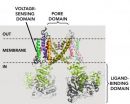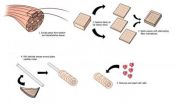(Press-News.org) (SALT LAKE CITY–Researchers have discovered that adding lovastatin, a widely used cholesterol-lowering drug, to traditional antimalarial treatment decreases neuroinflammation and protects against cognitive impairment in a mouse model of cerebral malaria. Although there are differences between mouse models of cerebral malaria and human disease, these new findings indicate that statins are worthy of consideration in clinical trials of cerebral malaria, according to an article published in the Dec. 27 issue of PLOS Pathogens.
Malaria, a parasitic infection that is transmitted to humans by the female Anopheles mosquito, is one of the leading infectious diseases worldwide. Cerebral malaria is a severe, potentially fatal neurologic complication of infection by the parasite Plasmodium falciparum. Studies of children with cerebral malaria show that cognitive deficits, such as impaired memory, learning, language, and mathematical abilities, persist in many survivors long after the infection itself is cured.
"Over 500,000 children develop cerebral malaria each year in sub-Saharan Africa, and persistent cognitive dysfunction in survivors is not only a major public health concern, but also a significant socioeconomic burden," says Guy Zimmerman M.D., associate chair for research in the Department of Medicine at the University of Utah and senior co-author on the study. "There is an urgent and unmet medical need for therapies that treat or prevent cognitive impairment in cerebral malaria."
Statins, a class of drugs best known for their ability to lower cholesterol, have also been shown to be active in modulating a variety of immune system responses. In their research, Zimmerman and his Brazilian colleagues evaluated the effect of statins in a mouse model of cerebral malaria. The researchers found that adding a drug called lovastatin to traditional antimalarial therapy prevented cognitive dysfunction in mice infected with cerebral malaria. They discovered that addition of lovastatin decreased white blood cell accumulation and leakiness in blood vessels in the brain. Lovastatin also reduced production of damaging oxygen-containing molecules and other factors that promote inflammation.
"The molecular mechanisms that give rise to cerebral malaria and subsequent cognitive dysfunction are not yet known," says Zimmerman. "However, the fact that statin treatment decreases both injurious blood vessel inflammation and cognitive dysfunction suggests that a combination of vascular and inflammatory triggers leads to cerebral pathology and intellectual deficits."
Zimmerman and his colleagues also studied lovastatin in an experimental model of bacterial sepsis, a severe whole-body inflammatory state that can also lead to cognitive impairment. They found that lovastatin also prevented cognitive impairment after bacterial sepsis.
"Our findings are exciting because the clinical implications extend beyond cerebral malaria to other severe systemic inflammatory syndromes complicated by brain involvement," says Zimmerman. "We believe our observations are the first experimental evidence to support the possibility of using statins to reduce cognitive impairment in critically ill patients."
### This study is the latest result of a long-term collaboration between Zimmerman and Dr. Hugo Castro-Faria-Neto and his group at the Oswaldo Cruz Foundation, a Brazilian research institute dedicated to the study, prevention, and treatment of infectious diseases. This collaboration began when Dr. Castro-Faria-Neto was a visiting scientist at the University of Utah. Future research will focus on additional investigation into the molecular mechanisms of cerebral malaria and the responses of key immune cells to malaria toxins, as well as on studies of the systemic inflammatory component of malaria in human patients.
Statin drug shows promise for fighting malaria effects
Lovastatin may decrease brain inflammation, mental deterioration associated with infection
2012-12-28
ELSE PRESS RELEASES FROM THIS DATE:
Staphylococcus aureus: Why it just gets up your nose!
2012-12-28
A collaboration between researchers at the School of Biochemistry and Immunology and the Department of Microbiology at Trinity College Dublin has identified a mechanism by which the bacterium Staphylococcus aureus (S. aureus) colonizes our nasal passages. The study, published today in the Open Access journal PLOS Pathogens, shows for the first time that a protein located on the bacterial surface called clumping factor B (ClfB) has high affinity for the skin protein loricrin.
S. aureus is a major human pathogen, with the potential to cause severe invasive diseases. It ...
The first genome sequence of Chinese plum provides important resource for fruit improvement
2012-12-28
December 27, 2012, Shenzhen, China - A Chinese research team, led by Beijing Forestry University, BGI, Beijing Lin Fu Ke Yuan Flowers Co., Ltd, and other institutes, has completed the first genomic sequence of Prunus mume, known as mei. This work is extremely important for the deeper understanding of Rosaceae evolution and provides an invaluable resource for the improvement of fruit trees. The latest study was published online today in Nature Communication.
As one of the longest-lived flowering fruit trees, the P. mume was domesticated in China more than 3,000 years ago. ...
Students' online and offline social networks can predict course grades -- Ben-Gurion U. researchers
2012-12-28
BEER-SHEVA, Israel, December 27, 2012 -- Ben-Gurion University of the Negev's (BGU) Social Networks Security Research Group in its Department of Information Systems Engineering has developed a novel method to predict how well or badly a student will perform in an academic course.
The information can be used to determine which students need the most help, as well as which ones excel and might be guided to further study or careers in that subject area. The paper, "Predicting Student Exam Scores by Analyzing Social Network Data," was presented earlier this month at the Advanced ...
A model-free way to characterize polymodal ion channel gating
2012-12-28
Two studies in The Journal of General Physiology (JGP) help pave the way for a "shortcut" model-free approach to studying activation of "polymodal" ion channels—channels that open in response to multiple stimuli. Transmembrane ion channels respond to various physiological stimuli to regulate numerous cellular functions. Different classes of channels respond to different types of stimuli; some channels, for instance, respond to changes in membrane potential whereas others are activated by ligand binding. Polymodal channels integrate different cellular signals, enabling them ...
Slice, stack, and roll: A new way to build collagen scaffolds
2012-12-28
MEDFORD/SOMERVILLE, Mass. (December, 26 2012) – Tufts University School of Engineering researchers have developed a novel method for fabricating collagen structures that maintains the collagen's natural strength and fiber structure, making it useful for a number of biomedical applications.
Collagen, the most abundant protein in the body, is widely used to build scaffolds for tissue engineering because it is biocompatible and biodegradable. Collagen is, however, hard to work with in its natural form because it is largely insoluble in water, and common processing techniques ...
GSA Bulletin celebrates GSA's 125th Anniversary with new geologic time scale
2012-12-28
Boulder, Colo., USA – GSA BULLETIN articles posted online between 10 Dec. and 21 Dec. 2012 include a new version of The Geological Society of America's Geologic Time Scale. This paper marks the beginning of a special series of invited papers in celebration of GSA's 125th Anniversary in 2013. Highlights are provided below.
1. A new/revised GSA geologic time scale.
2. Complex mammal fossil record of the Gran Barranca, Patagonia, Argentina.
3. A new and simple method for estimating the rate of sediment delivery to ancient basins.
4. A study of the provenance of volcanic ...
Monkey see, monkey do: Visual feedback is necessary for imitating facial expressions
2012-12-28
Research using new technology shows that our ability to imitate facial expressions depends on learning that occurs through visual feedback.
Studies of the chameleon effect confirm what salespeople, tricksters, and Lotharios have long known: Imitating another person's postures and expressions is an important social lubricant.
But how do we learn to imitate with any accuracy when we can't see our own facial expressions and we can't feel the facial expressions of others?
Richard Cook of City University London, Alan Johnston of University College London, and Cecilia Heyes ...
Strange behavior: New study exposes living cells to synthetic protein
2012-12-28
One approach to understanding components in living organisms is to attempt to create them artificially, using principles of chemistry, engineering and genetics. A suite of powerful techniques—collectively referred to as synthetic biology—have been used to produce self-replicating molecules, artificial pathways in living systems and organisms bearing synthetic genomes.
In a new twist, John Chaput, a researcher at Arizona State University's Biodesign Institute and colleagues at the Department of Pharmacology, Midwestern University, Glendale, AZ have fabricated an artificial ...
Penn team developing new class of malaria drugs using essential calcium enzyme
2012-12-28
PHILADELPHIA - Calpain, a calcium-regulated enzyme, is essential to a host of cellular processes, but can cause severe problems in its overactivated state. It has been implicated as a factor in muscular dystrophy, AIDS, Alzheimer's disease, multiple sclerosis, and cancer. As such, finding and exploiting calpain inhibitors is an important area of research.
A team from the Perelman School of Medicine, University of Pennsylvania, in collaboration with the University of California at San Francisco and the Department of Biochemistry and Protein Function Discovery at Queen's ...
Vanderbilt study examines Affordable Care Act's impact on uncompensated care
2012-12-28
Nashville (Tenn.) - The decision by several states not to expand Medicaid health insurance for the poor may create unintended cuts for hospitals that provide uncompensated care, according to a study by John Graves, Ph.D., a Vanderbilt policy expert in the Department of Preventive Medicine.
Graves used financial data from U.S. hospitals and insurance data in each state to predict cuts in Medicare and Medicaid disproportionate share (DSH) funds paid to the nearly three-fourths of U.S. hospitals that serve low-income patients. The results, published in the Dec. 20 issue ...
LAST 30 PRESS RELEASES:
This new understanding of T cell receptors may improve cancer immunotherapies
A new fossil face sheds light on early migrations of ancient human ancestor
A new immunotherapy approach could work for many types of cancer
A new way to diagnose deadly lung infections and save lives
40 percent of MRI signals do not correspond to actual brain activity
How brain-inspired algorithms could drive down AI energy costs
Gum disease may be linked to plaque buildup in arteries, higher risk of major CVD events
Contrails are a major driver of aviation’s climate impact
Structure of dopamine-releasing neurons relates to the type of circuits they form for smell-processing
Reducing social isolation protects the brain in later life
Keeping the heart healthy increases longevity even after cancer
Young adults commonly mix cannabis with nicotine and tobacco
Comprehensive review illuminates tau protein's dual nature in brain health, disease, and emerging psychiatric connections
Book prepares K-12 leaders for the next public health crisis
Storms in the Southern Ocean mitigates global warming
Seals on the move: Research reveals key data for offshore development and international ecology
Sports injuries sustained during your period might be more severe
World's first successful 2 Tbit/s free-space optical communication using small optical terminals mountable on satellites and HAPS
Can intimate relationships affect your heart? New study says ‘yes’
Scalable and healable gradient textiles for multi‑scenario radiative cooling via bicomponent blow spinning
Research shows informed traders never let a good climate crisis go to waste
Intelligent XGBoost framework enhances asphalt pavement skid resistance assessment
Dual-function biomaterials for postoperative osteosarcoma: Tumor suppression and bone regeneration
New framework reveals where transport emissions concentrate in Singapore
NTP-enhanced lattice oxygen activation in Ce-Co catalysts for low-temperature soot combustion
Synergistic interface engineering in Cu-Zn-Ce catalysts for efficient CO2 hydrogenation to methanol
COVID-19 leaves a lasting mark on the human brain
Scientists use ultrasound to soften and treat cancer tumors without damaging healthy tissue
Community swimming program for Black youth boosts skills, sense of belonging, study finds
Specific depressive symptoms in midlife linked to increased dementia risk
[Press-News.org] Statin drug shows promise for fighting malaria effectsLovastatin may decrease brain inflammation, mental deterioration associated with infection



